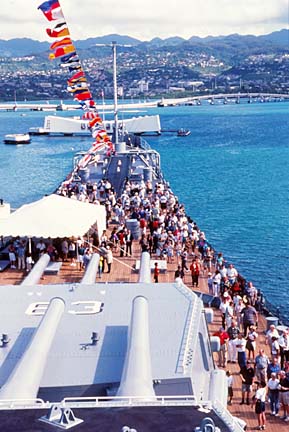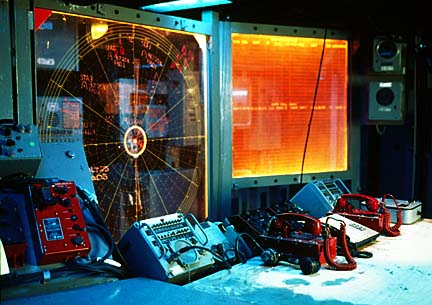

[ SUNDAY TRAVEL ]

USS Missouri WHEN the Japanese bombed Pearl Harbor on Dec. 7, 1941, catapulting the United States into World War II, the USS Missouri was under construction an ocean and a continent away at the New York Naval Shipyard. Today, Pearl Harbor is home to the mammoth battleship, which has drawn more than 750,000 visitors since its opening as a museum in January 1999.
has a moving
history
From World War II to
Desert Storm, the Mighty
Mo holds a distinguished recordBy Cheryl Chee Tsutsumi
Special to the Star-BulletinThe Missouri claims a long and distinguished record of service. Six years of bloodshed that spanned the globe ended in 20 minutes on her teak deck, Sept. 2, 1945, in Tokyo Bay. With the ship's guns lowered and silent, Japanese dignitaries and leaders of the Allied forces signed the Formal Instrument of Surrender at a cloth-draped table from the Missouri's mess hall, officially ending World War II.
From the day this legend was launched, Jan. 29, 1944, her singular purpose of battle was unquestionable. Nearly as long as three football fields, she required 70 tons of blueprints. She was an extraordinary feat of engineering, housing four 24,400-horsepower turbines, 90 miles of piping, 15,000 valves and 900 electric motors.
On board was enough weaponry to level a city: nine 16-inch guns (the largest guns the U.S. Navy ever built), 20 5-inch guns, 80 40-millimeter guns and 49 20-millimeter guns. Steel armor lined her sides, more than 17 inches thick in some areas. A virtually impregnable fortress, it was amazing she could float, let alone carry a crew of 2,400 sailors and Marines, and skim the waves at a swift (for her size) 30 knots per hour.

In short, the Missouri was the biggest, fastest and most heavily armed warship the United States had ever built. The nickname "Mighty Mo" was born and stuck, "MO" being the two-letter abbreviation for the state of Missouri.Although she only served during the last eight months of World War II, the vessel earned her revered place in history books. In addition to being the site of the surrender ceremony, she played a key role in decisive battles in Iwo Jima and Okinawa, and she served as the flagship for famed Adm. William "Bull" Halsey.
In 1955, after completing two tours of duty in the Korean War, Missouri was decommissioned and placed in mothballs. She was modernized and recommissioned in 1986, and deployed to the Persian Gulf in 1991, launching missile attacks against Iraqi forces in Kuwait and Baghdad. Her final mission was participating in ceremonies at Pearl Harbor on Dec. 7, 1991, commemorating the 50th anniversary of the Japanese attack.
The Missouri was decommissioned for the second time in 1992. Three years later, she was removed from the Navy's ship registry, clearing the way for her to embark on a new mission of education. Guided tours of the battleship include the new 90-minute Captain's Tour, which transports visitors back in time to 1991, the height of the Gulf War. Guests enjoy light snacks and refreshments in the Captain's Cabin while they receive a formerly classified brief given to the U.S. forces prior to initiating Operation Desert Storm. The briefing is followed by a behind-the-scenes look at the Missouri's weapons system; an inspection of the bridge, command and control centers; and a stop at the Surrender Deck, where Gen. Douglas MacArthur and the Allied Forces accepted Japan's surrender.
The Battleship Explorer Tour is set to kick off late this summer. Participants will be provided with hard hats, glow-in-the-dark vests, flashlights and water bottles. They'll descend into the bowels of the Missouri to view the brig, barbershop, laundry, post office, "Broadway" (the long corridor that connects the ship's engine rooms) and much more.
Lee J. Collins Sr., a retired senior chief operations specialist for the Navy and a veteran of Operation Desert Storm, serves as director of visitor operations for the Battleship Missouri Memorial. Among other tasks, he is charged with managing daily visitor operations and the overall visitor experience. No one leaves the Missouri without being touched by stories of valor and heroism, Collins says. One in particular stands out in his mind.
The president of the Japanese Democratic Party was in Hawaii on a fact-finding mission following the Ehime Maru tragedy in February, and visited the ship with two senior Japanese government officials. Recalls Collins: "I met them at the gate with Masaji, one of our Japanese tour guide supervisors, and presented them with Missouri admiral hats normally provided to dignitaries. They were polite but did not put the hats on as there were numerous Japanese visitors also there who knew them, and the investigation of the Ehime Maru sinking was not yet done."
Battleship Missouri Memorial Location: Pier Foxtrot-5, Ford Island, Pearl Harbor
Mailing address: P.O. Box 6339, Honolulu, HI 96818
Time: Open from 9 a.m. to 5 p.m. daily
General admission: $14 for adults, $7 for children age 4 to 12 for self-guided tours. Kamaaina are $10 and $5, respectively. Guided tours, which take visitors to areas of the ship that are not open to those buying general admission, are available for an additional fee. Ask about the Battleship Missouri Encampment Program, a shipboard camping experience designed for youth groups age 6 through 17.
Phone: 973-2494 on Oahu and (877) 644-4896 from the other islands.
Web site: www.ussmissouri.com
Collins and Masaji escorted the three men on a tour of the ship. The Japanese officials listened respectfully as Masaji described the Missouri's accomplishments. When the group proceeded aft to the fantail, Masaji shared the story of a kamikaze pilot who had struck the ship off Okinawa on April 11, 1945. Miraculously, no one on board was killed, but the pilot perished. Missouri Capt. William Callaghan decided the young man was to be buried at sea with honors the next day.
The crew was concerned. Bury the enemy with honors? That didn't seem right. But, says Collins, Capt. Callaghan was firm, explaining that they would be paying tribute to "a fellow warrior who had displayed courage and devotion, and who had paid the ultimate sacrifice with his life, fighting for his country." The captain noted the ceremony was not intended to glorify Japan, kamikazes, Japanese pilots or even World War II, but to recognize an individual honorable warrior. Three of the Missouri's sailors stayed up through the night sewing a Japanese flag so that this warrior could be buried with the proper respect.
"The Japanese emissaries were openly weeping by now," remembers Collins, "and they lifted their Missouri ball caps, snapped them open and placed them securely on their heads with pride.
"I guess what I enjoy most is the education we provide our international visitors and our children. The USS Missouri is one of the world's most important pieces of history. She is not only an American icon, but an international icon, representing duty, honor, courage, commitment and willingness to pay the ultimate sacrifices for freedom."
Cheryl Chee Tsutsumi is a Honolulu-based free-lance writer.